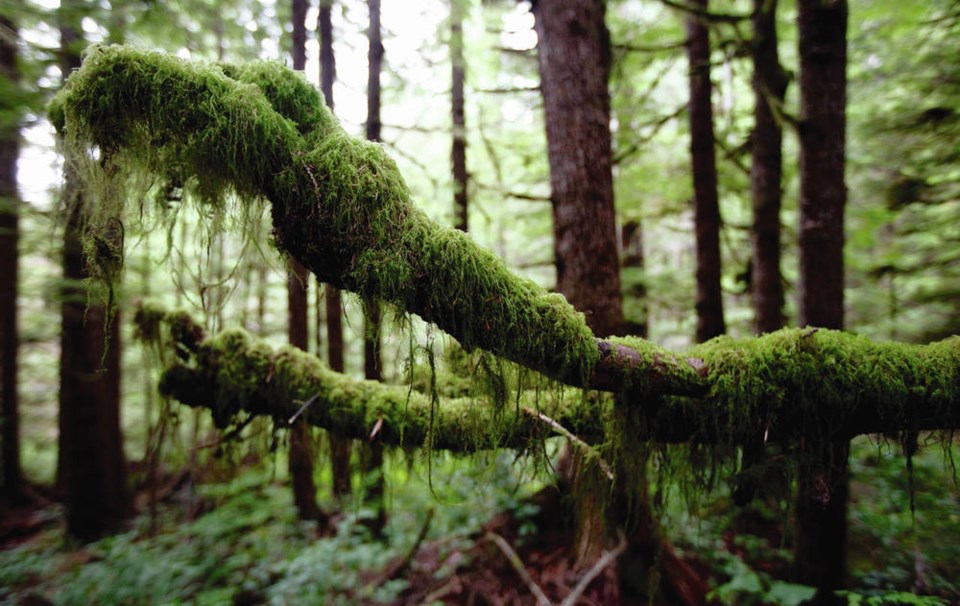A commentary by a retired forest ecologist and retired professional forester and professional biologist.
When a province’s motto is invoked ironically, it may be time to reconsider that motto.
British Columbia’s provincial motto is Splendor sine occasu, a Latin phrase usually translated as “Splendour without diminishment.” Narrowly defined, it was intended to refer to the sun on the provincial shield that “although setting, never decreases.”
But the “splendour” applies equally well to the entire province. B.C. has more topography than any other province or territory — more mountain ranges, more coastlines. It has more climatic zones, more ecosystems and species than anywhere else in Canada. Or perhaps anywhere else in the world at temperate latitudes.
And that “splendour” — B.C.’s natural heritage — has been greatly diminished by our activities. This applies to our oceans and our freshwater as well, but today I’d like to focus on B.C.’s old-growth forests.
More than 80 per cent of B.C. is covered with forest — we are truly a forested province. There are more types of forest in B.C. than anywhere else in Canada, from our northern boreal forests to our coastal rainforests. For thousands of years, these forests have provided the essentials of life for B.C.’s First Nations. And they’ve provided habitat for our province’s plants, animals and fungi.
But today, we find our rich forest endowment greatly diminished. B.C. logs considerably more forest each year than any other province.
Except where we’ve built large cities, however, we haven’t deforested our province. We’ve simply clearcut our original (old-growth) forests, and regenerated second-growth forests.
But these second-growth forests are profoundly different from the forests that were logged, in just about any way you can imagine. They are different structurally and functionally, and they provide little in the way of habitat for the many species that have adapted over millennia to life in old-growth forests.
And so perhaps it’s not surprising that B.C. leads Canada in another category — we have more threatened and endangered species than any other province or territory.
One area that B.C. doesn’t lead Canada is in protecting old-growth forests and species at risk. We remain one of the few provinces without endangered species legislation.
For old-growth forests with very big old trees, only about three per cent (about 35,000 hectares) remains today outside of protected areas. That’s certainly splendour diminished.
The NDP government’s Old Growth Panel called for a deferral on logging on the most at-risk old-growth forests within six months of publication of its report.
It has been more than a year now, a year during which the rate of old-growth logging has accelerated considerably. The NDP government promised endangered species legislation for our province, but has subsequently changed their mind.
While independent scientists (using provincial government inventory data) have clearly documented and mapped how little high-productivity old-growth forest remains, the provincial government and industry continue to assure us that there is lots left, and they’re developing a plan.
Talk and log. There’s an urgency to this issue — every week fewer of these iconic forests remain.
Fortunately, more and more people are rejecting the “relax, we’re on it” message of the provincial government and industry.
Instead, they’re listening to what independent scientists are saying, or they’re paying attention to what air photos and satellite images are making abundantly clear. Or perhaps they simply appreciate what they see when they drive the backroads of our province.
For old-growth forests and species at risk, there is no objective on-the-ground difference between Christy Clark’s B.C. Liberals and John Horgan’s NDP. They share the same legislation and policies.
Perhaps the biggest difference is that the NDP promised to be a champion for forests and species, and the Liberals never did. That certainly makes the inaction of the NDP seem all the more appallingly cynical.
Activists frustrated at the inaction of our provincial government are beginning to take direct nonviolent action at roadblocks in Fairy Creek and elsewhere.
B.C.’s natural splendour is certainly diminished. But there are clear opportunities for our governments to protect some of what’s left.
For old-growth forests, the recommendations of the government’s own Old Growth Panel report provide an excellent path forward.
The NDP have promised to implement these recommendations. Now, all that’s required is the political will to keep their promises.



